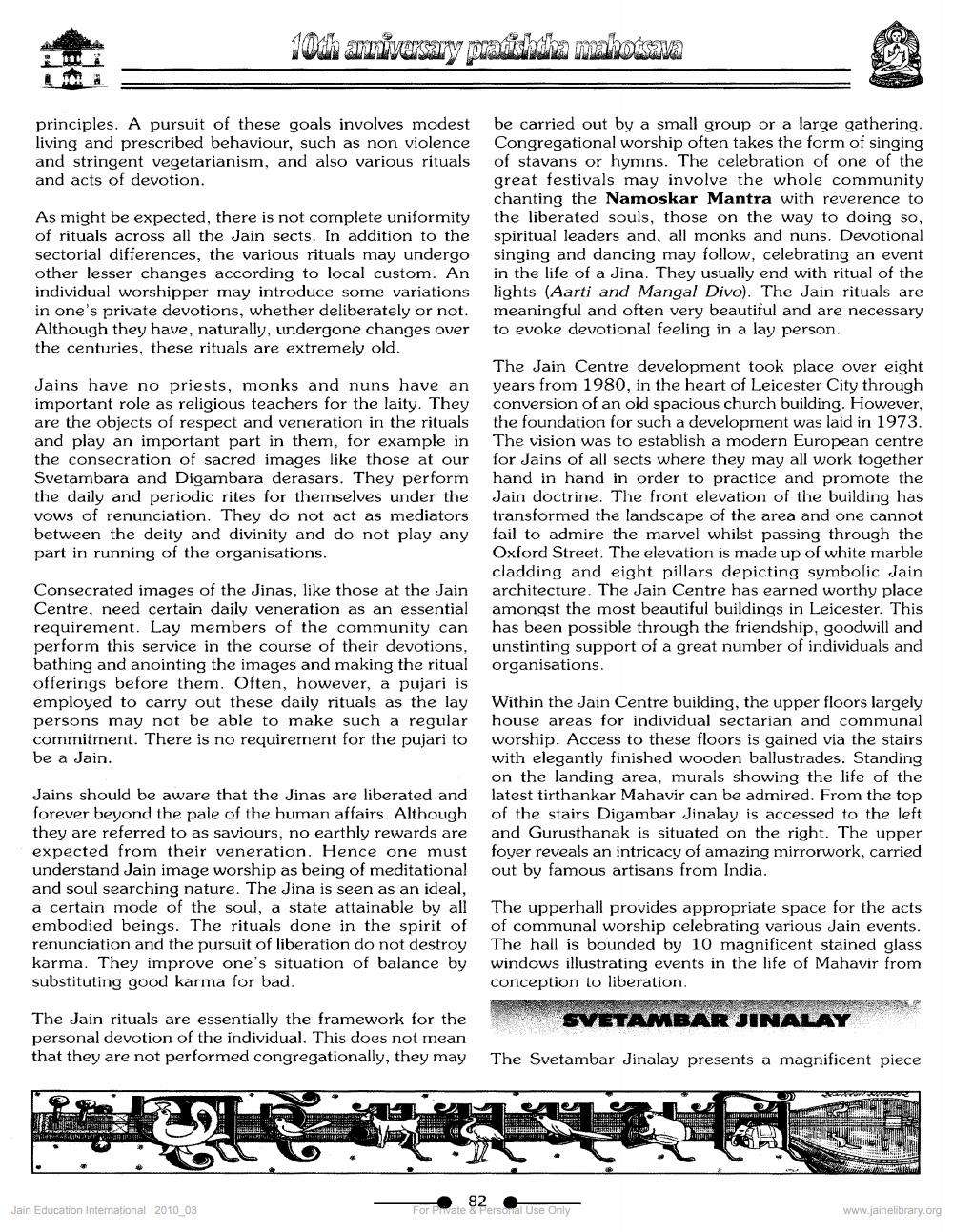________________
L
10th anniversary pratishtha mahotava
principles. A pursuit of these goals involves modest living and prescribed behaviour, such as non violence and stringent vegetarianism, and also various rituals and acts of devotion.
As might be expected, there is not complete uniformity of rituals across all the Jain sects. In addition to the sectorial differences, the various rituals may undergo other lesser changes according to local custom. An individual worshipper may introduce some variations in one's private devotions, whether deliberately or not. Although they have, naturally, undergone changes over the centuries, these rituals are extremely old.
Jains have no priests, monks and nuns have an important role as religious teachers for the laity. They are the objects of respect and veneration in the rituals and play an important part in them, for example in the consecration of sacred images like those at our Svetambara and Digambara derasars. They perform the daily and periodic rites for themselves under the vows of renunciation. They do not act as mediators between the deity and divinity and do not play any part in running of the organisations.
Consecrated images of the Jinas, like those at the Jain Centre, need certain daily veneration as an essential requirement. Lay members of the community can perform this service in the course of their devotions, bathing and anointing the images and making the ritual offerings before them. Often, however, a pujari is employed to carry out these daily rituals as the lay persons may not be able to make such a regular commitment. There is no requirement for the pujari to be a Jain.
Jains should be aware that the Jinas are liberated and forever beyond the pale of the human affairs. Although they are referred to as saviours, no earthly rewards are expected from their veneration. Hence one must understand Jain image worship as being of meditational and soul searching nature. The Jina is seen as an ideal, a certain mode of the soul, a state attainable by all embodied beings. The rituals done in the spirit of renunciation and the pursuit of liberation do not destroy karma. They improve one's situation of balance by substituting good karma for bad.
The Jain rituals are essentially the framework for the personal devotion of the individual. This does not mean that they are not performed congregationally, they may
Jain Education International 2010_03
be carried out by a small group or a large gathering. Congregational worship often takes the form of singing of stavans or hymns. The celebration of one of the great festivals may involve the whole community chanting the Namoskar Mantra with reverence to the liberated souls, those on the way to doing so, spiritual leaders and, all monks and nuns. Devotional singing and dancing may follow, celebrating an event in the life of a Jina. They usually end with ritual of the lights (Aarti and Mangal Divo). The Jain rituals are meaningful and often very beautiful and are necessary to evoke devotional feeling in a lay person.
The Jain Centre development took place over eight years from 1980, in the heart of Leicester City through conversion of an old spacious church building. However, the foundation for such a development was laid in 1973. The vision was to establish a modern European centre for Jains of all sects where they may all work together hand in hand in order to practice and promote the Jain doctrine. The front elevation of the building has transformed the landscape of the area and one cannot fail to admire the marvel whilst passing through the Oxford Street. The elevation is made up of white marble cladding and eight pillars depicting symbolic Jain architecture. The Jain Centre has earned worthy place amongst the most beautiful buildings in Leicester. This has been possible through the friendship, goodwill and unstinting support of a great number of individuals and organisations.
Within the Jain Centre building, the upper floors largely house areas for individual sectarian and communal worship. Access to these floors is gained via the stairs with elegantly finished wooden ballustrades. Standing on the landing area, murals showing the life of the latest tirthankar Mahavir can be admired. From the top of the stairs Digambar Jinalay is accessed to the left and Gurusthanak is situated on the right. The upper foyer reveals an intricacy of amazing mirrorwork, carried out by famous artisans from India.
The upperhall provides appropriate space for the acts of communal worship celebrating various Jain events. The hall is bounded by 10 magnificent stained glass windows illustrating events in the life of Mahavir from conception to liberation.
SVETAMBAR JINALAY
The Svetambar Jinalay presents a magnificent piece
82
For Private & Personal Use Only
www.jainelibrary.org




